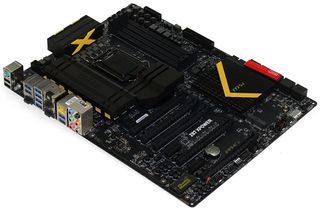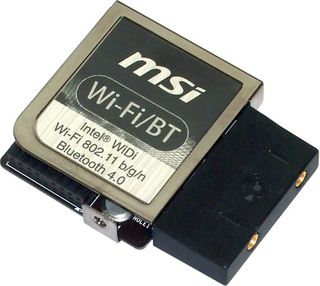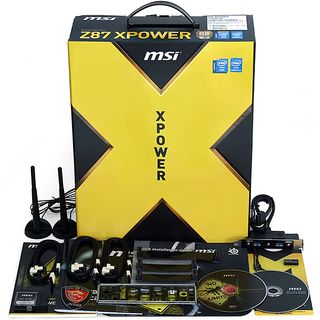Four Z87 Express Motherboards For Three- And Four-Way SLI
Formerly a very exclusive component, the PCI Express switch that makes Intel’s LGA 1150-based platforms three- and four-way SLI-capable is now available across a range of high-end motherboards. Today we compare four premium enthusiast-oriented models.
MSI Z87 XPower
MSI has no trouble with crowded components, spreading its Z87 XPower to an XL-ATX size that could have potentially supported up to nine expansion slots. It omits the top two slot connectors, though, to make more room around the CPU socket. With the same slot layout as competing samples from ASRock and Gigabyte, we have to ask: what does all that space provide?

The I/O panel has eight USB 3.0 and two USB 2.0 ports, yet it’s no larger than standard, and at least one competitor matches that array of connectivity with an ATX-sized board. CPU-based graphics connectors include two HDMI ports and one DisplayPort connector, but without the additional Thunderbolt controller offered by two competitors. Gigabit Ethernet also gets kicked down to a single port and controller, and there is a noticeable gap above the CLR_CMOS button.

That gap gets filled with the same 802.11n single-band Wi-Fi/Bluetooth module seen in our Z87 MPower review, which is less valuable than the dual-band 802.11ac card installed on ASRock’s sample. On the other hand, it resolves the slot issue faced by Gigabyte in three- and four-way SLI configurations. Also important is that it doesn’t require the use of a 5.25” bay for its antennas.

MSI includes overclocking control buttons for CPU ratio and BCLK, along with a power discharge button for CLR_CMOS, an auto-OC button, a power button, and a collection of voltage detection pins at the front edge. But those additions cause the board to be wider from front to back, not from top to bottom, and are matched by Gigabyte’s ATX-sized sample.

A look at the top shows what this motherboard's layout includes. Part of the PCB is consumed by an mSATA slot, but that’s not where the Z87 XPower was stretched. Heat sinks fill most of the area that MSI expanded, but the 32-phase voltage regulator covered by two of those sinks is the hidden prize. Fed by two eight-pin EPS12V connectors, that voltage regulator should be able to put out enough current for serious overclocking attempts. It's only a shame that Intel's Haswell-based processors don't appear very scalable on air or water cooling. While we might question the usefulness of such a large voltage regulator, the extra space it consumes also enables owners of 10-slot cases to fill them up with an appropriately-sized motherboard without any extra space at the bottom.
Can we assume that any manufacturer specialized enough to offer nine- and 10-slot enclosures would also be wise enough to make their front-panel audio cables long enough to reach the bottom-rear corner of a motherboard? MSI doesn’t leave this chance, moving its front-panel audio connector just to be safe. The remaining layout is good as well, including ten forward-facing SATA 6Gb/s connectors that are fed by a combination of the chipset’s controller and two PCIe x1 dual-port controllers.

Vacant slot positions at the top of the board should be filled with something, so MSI includes a two-port USB 3.0 breakout plate for one of the Z87 XPower’s two front-panel headers. Buyers also get two wireless antennas, six SATA cables, and three flexible SLI bridges that can be used for four-way SLI by connecting the first card to the second, the third card to the fourth, and the fourth back to the second. Because they’re flexible, three-way SLI is also supported by connecting cards one to two, cards two to three, and cards three to one (cross-ways).
Stay on the Cutting Edge
Join the experts who read Tom's Hardware for the inside track on enthusiast PC tech news — and have for over 25 years. We'll send breaking news and in-depth reviews of CPUs, GPUs, AI, maker hardware and more straight to your inbox.
-
iam2thecrowe Am i missing something here? I dont see the point of reviewing 3 and 4 way sli boards and not testing 3 and 4 way sli. Seems rather pointless since any average motherboard will perform well in adobe, productivity etc benches dependent on the cpu....Reply -
Crashman This was really just about finding any board that supports Nvidia's requirements about how that third card is connected. We found some, I overclocked them, now I have enough data to pick a board for the System Builder Marathon. But that only explains why overclocking took priority!Reply
After spending two days per board on a "one week" article, I couldn't add more tests. The general benchmark set looks for unintended overclocking/underclocking, power and memory bandwidth issues, so you can see the performance difference attributable to each board's CPU and DRAM configuration differences. It runs from a .bat file, so it didn't add significantly to the article's completion time.
The PLX bridge that these all share represents the "great equalizer" when it comes to CrossFire and SLI configuration, so that portion of all three boards should be identical. I understand that things that should be the same in theory are occasionally different in practice. My apologies for not having the extra 1-day per board for additional tests. -
iam2thecrowe Reply12341788 said:They all use the same PLX bridge, so you would have seen a whole bunch of identical gaming results. The general benchmark set looks for unintended overclocking/underlocking, power and memory bandwidth issues, so you can see the actual performance difference. And there's still an overclocking section.
These boards had to be tested for general performance and stability like any other boards. The PLX controller is the equalizer when it comes to games.
I think testing 3/4 way sli would still be valid, as it doesn't always work properly, in the past there have been compatibility problems with certain gpu's/boards/firmware/controllers and certain benchmarks completely failed. -
Kraszmyl "internally-mounted external USB 2.0 port for ReadyBoost fanatics" on the asus z87.Reply
Those have nothing to do with readyboost. The internal usb ports are very common on workstations and you put CAD dongles and equivalent items in them so that you can lock them inside the case and don't have to worry about some one stealing them from the outside or them taking up an outside usb port. -
Memnarchon I would love to see Asus Maximus VI Extreme, but it seems ASUS didn't want to give a 2nd board and prefered the Z87 WS....Reply -
Traciatim where are the sli/crossfire benchmarks and comparisons with traditional non-switched setups?Reply
Hey guys, we have these awesome new setups for supreme graphics pumping power! Watch it zip files like every other board! -
duramax08 Why are they still making motherboards with PS/2 connections? Its time to move on, replace those baby's with some USB 3.0!Reply

